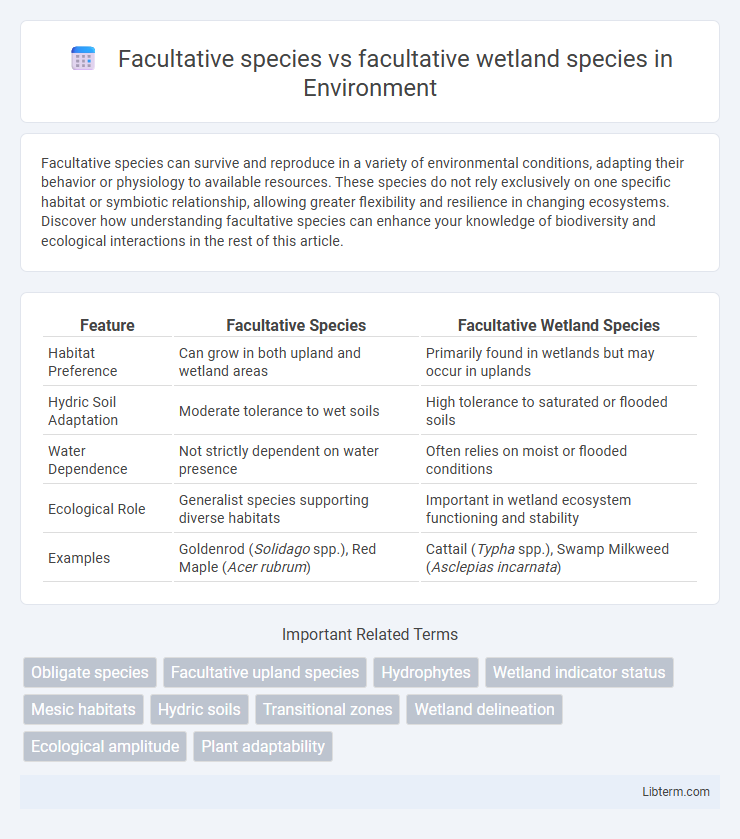Facultative species can survive and reproduce in a variety of environmental conditions, adapting their behavior or physiology to available resources. These species do not rely exclusively on one specific habitat or symbiotic relationship, allowing greater flexibility and resilience in changing ecosystems. Discover how understanding facultative species can enhance your knowledge of biodiversity and ecological interactions in the rest of this article.
Table of Comparison
| Feature | Facultative Species | Facultative Wetland Species |
|---|---|---|
| Habitat Preference | Can grow in both upland and wetland areas | Primarily found in wetlands but may occur in uplands |
| Hydric Soil Adaptation | Moderate tolerance to wet soils | High tolerance to saturated or flooded soils |
| Water Dependence | Not strictly dependent on water presence | Often relies on moist or flooded conditions |
| Ecological Role | Generalist species supporting diverse habitats | Important in wetland ecosystem functioning and stability |
| Examples | Goldenrod (Solidago spp.), Red Maple (Acer rubrum) | Cattail (Typha spp.), Swamp Milkweed (Asclepias incarnata) |
Introduction to Facultative and Facultative Wetland Species
Facultative species are plants that can thrive in both wetland and non-wetland environments, demonstrating ecological adaptability across diverse habitats. Facultative wetland species specifically prefer wetland conditions but can also survive in non-wet areas, making them important indicators in wetland delineation and ecological studies. Understanding the distinction between facultative and facultative wetland species helps in accurate habitat classification and conservation planning.
Defining Facultative Species
Facultative species are plants or animals capable of thriving in multiple habitat types, demonstrating adaptability to both wet and dry environments. Facultative wetland species specifically occur in wetlands or non-wetlands but are predominantly found in wetland areas, indicating a strong preference for moist conditions while tolerating occasional dryness. Understanding facultative species is essential for ecological assessments and wetland delineation because their presence helps indicate the hydrologic conditions of an area.
What Are Facultative Wetland Species?
Facultative wetland species are plants that typically occur in wetlands but can also thrive in non-wetland environments, adapting to varying moisture conditions. These species have a probability range of 34-66% of being found in wetlands, distinguishing them from facultative species, which have a broader habitat tolerance ranging between wetland and upland areas. Understanding facultative wetland species is crucial for wetland delineation and ecosystem management, as they indicate transitional zones between aquatic and terrestrial habitats.
Key Differences Between Facultative and Facultative Wetland Species
Facultative species thrive in a wide range of habitats, including both wet and dry environments, with no strict dependence on water presence, whereas facultative wetland species predominantly occur in wetlands but can also survive in non-wetland areas. Facultative wetland species have an estimated 34% to 66% probability of growing in wetland habitats, reflecting their adaptability to saturated soil conditions, while facultative species show a broader ecological amplitude. Understanding these differences is critical for wetland delineation, conservation planning, and ecological restoration efforts.
Ecological Roles of Facultative Species
Facultative species exhibit flexible habitat preferences, thriving in both wetland and non-wetland environments, which allows them to stabilize ecosystems by supporting biodiversity across varying moisture gradients. Facultative wetland species, specifically adapted to moist conditions but capable of surviving in drier areas, contribute to nutrient cycling and water filtration in transitional zones between aquatic and terrestrial habitats. Their ecological role includes enhancing resilience against environmental fluctuations, promoting habitat connectivity, and sustaining food web dynamics in diverse landscapes.
Adaptations of Facultative Wetland Species
Facultative wetland species possess specialized adaptations such as aerenchyma tissue for enhanced oxygen transport to roots, enabling survival in saturated, anaerobic soil conditions typical of wetlands. These species often exhibit flexible root systems and tolerance to fluctuating water levels, allowing them to thrive in both aquatic and terrestrial environments. In contrast, facultative species lack these specific wetland adaptations and are generally found in a broader range of habitats without the same degree of hydrophytic specialization.
Habitat Preferences and Distribution
Facultative species thrive in multiple habitats but typically prefer upland environments, showing variable tolerance to wet conditions, while facultative wetland species predominantly occupy wetland habitats yet can occasionally be found in non-wetland areas. Facultative wetland species exhibit adaptations for saturated soils and fluctuating water levels common in wetlands, contributing to their distribution in marshes, swamps, and floodplains. Distribution patterns of facultative species are broader, spanning upland forests, meadows, and disturbed sites, reflecting their flexible habitat preferences compared to the more hydrophilic facultative wetland species.
Examples of Facultative and Facultative Wetland Species
Facultative species, such as red maple (Acer rubrum) and green ash (Fraxinus pennsylvanica), can thrive in both wetland and non-wetland environments. Facultative wetland species, including silver maple (Acer saccharinum) and buttonbush (Cephalanthus occidentalis), predominantly occur in wetlands but also survive in non-wetland areas. These distinctions are critical for wetland delineation and ecological restoration projects, as the presence of facultative species indicates transitional habitat conditions.
Importance in Wetland Delineation and Conservation
Facultative species and facultative wetland species are critical indicators in wetland delineation and conservation efforts, as they provide essential information about hydrologic conditions and habitat quality. Facultative species can thrive in both wet and dry environments, while facultative wetland species predominantly occur in wetlands but also survive in non-wetland areas, aiding in precise boundary identification between aquatic and terrestrial ecosystems. Their presence helps ecologists assess wetland functions, support biodiversity, and prioritize areas for protection and restoration.
Conclusion: Understanding Their Ecological Significance
Facultative species have the ability to thrive in multiple habitats, adapting to both wet and dry conditions, while facultative wetland species predominantly occur in wetlands but can also survive in non-wetland areas. Recognizing these distinctions enhances ecosystem management by identifying species that contribute to habitat resilience and biodiversity across varying environmental gradients. Understanding their ecological roles assists in wetland conservation efforts, land-use planning, and predicting vegetation responses to climate change.
Facultative species Infographic

 libterm.com
libterm.com